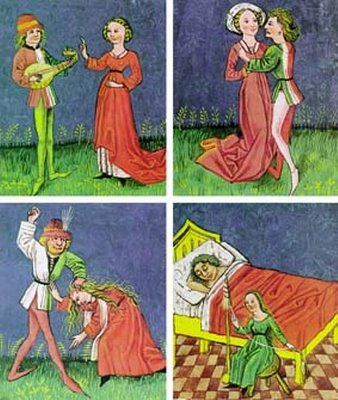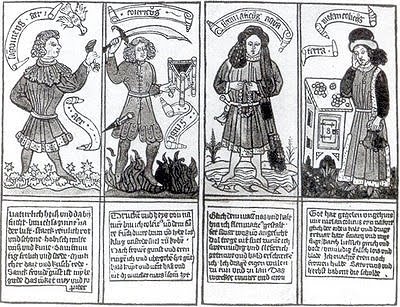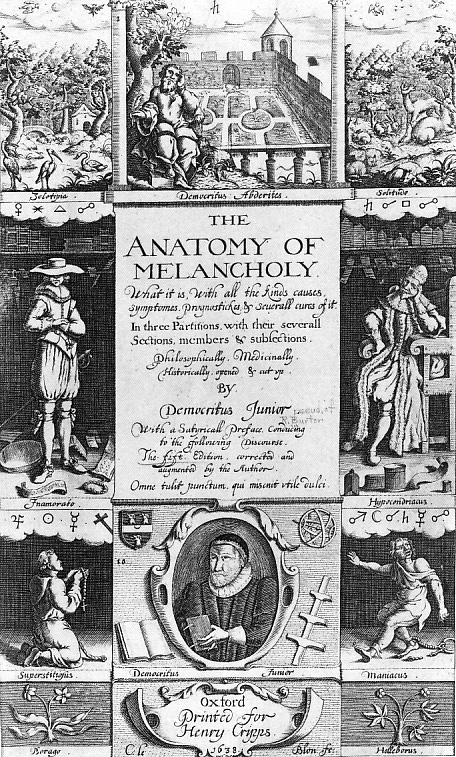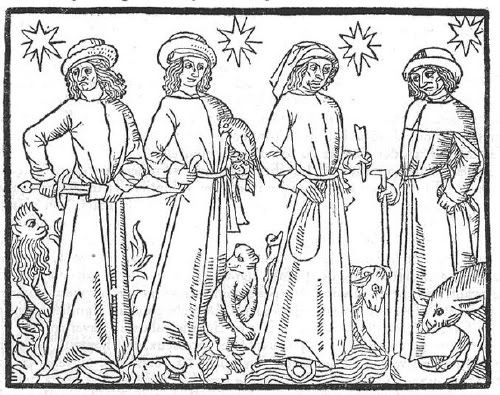Robert wrote,
so I've been studying the four humours and contemplating the relationship to tarot).
Good luck in your studies, Robert. I sort of thought you were the moderator or something. Or does this forum run itself?
I agree strongly that the four humors are related to the tarot. Here is some food for thought, since you are studying them. Psychologically, they relate both to four personality types (like suits) and four times of life (like pages, knights, queens and kings). So they naturally fit the court cards.
For personality types, we have a quaternity, i.e. two pairs of opposites: agitated (choleric) vs. calm (phlegmatic), and cheerful (sanguine) vs. depressed (melancholic). Here are a couple of Renaissance-era pictures.
Traditionally, sanguine was associated with childhood; then came choleric, then melancholic, and finally phlegmatic in old age. This progression was modeled on the seasons in Greece: the new life of spring, hot summer, dry autumn, and wet winter. But this is too mechanical for the tarot, or life; moreover, in one of the above pictures (with the symbolic distaff for fate), melancholy applies to the end of life. I'd just say the more energetic humors (sanguine, choleric) apply more to the first half of life, the lesser (melancholic, phlegmatic) to the second half.
With these descriptions and pictures in mind--forgetting the Golden Dawn and whatever you have read on the courts--look at the Noblet courts (
http://letarot.com/jean-noblet/pages/je ... neurs.html) in relation to the four humors.
Cups, phlegmatic (calm, agreeable): Page as young troubadour; Knight in service to his Lady; dreamy, meditative Queen; King as congenial host.
Swords, choleric (aggressive, angry, fearful): Page, not too sure about entering military life; Knight as efficient killing machine; Queen angry and fearful, her husband away at war; King as successful in the world but sitting uneasily on the throne.
Batons, Sanguine (interested, engaged, optimistic). Page, pleased at his big stick; Knight, overconfident in battle, his club will be no match for swords, and he should be looking ahead, not at his stupid weapon; Queen, the happy lactating mother; King, the big fish in the little pond, i.e. his little anachronistic kingdom in the hills, enjoying the show.
Coins, melancholic (sadness, disinterest): Page as young street-hawker trying to drum up business; Knight, the traveling merchant, every night a different bed; Queen, regretting how dazzled she's been by her husband's wealth, when there are more important considerations; King, what happiness has gold brought me? This last suit reflects a very different set of values than is common today, pre-capitalist in orientation, very old-fashioned. I am being historical. The theory still works, but people may have a hard time thinking of coins as symbols of sadness.
Particular courts, with their humors, connect to particular trumps as well. But the connections are manifold: not just Swords to sharp things, Batons to sticks, Cups to vessels, and Coins to round things, but to gender, beards, posture, gesture, age, etc.
There are exercises you can do to balance the humors. Two examples are the top two pictures above: phlegmatic music (of the Renaissance variety) to "calm the savage beast," and sanguine dancing to perk up the depressed. There are many more exercises, probably common knowledge in the Renaissance. I like to think that
Romeo and Juliet and other Shakespeare plays reflect them; either that, or he was a fantastic psychologist (also likely). These days, It helps to know a particular type of psychotherapy called cognitive-emotive therapy, which uses similar techniques to manage emotions.
The specific brand of cognitive-emotive therapy most used in my geographical area, at least in government and insurance funded treatment centers, is called Dialectical Behavioral Therapy (DBT), "dialectical" referring to pairs of opposites. Its effectiveness was documented by Marsha Lanahan in clinical trials at the University of Washington. You keep in mind both parts of a pair, and modulate one by engaging an aspect of the other. There are several good self-help books based on this theory, with exercises. The most relevant one is
Don't Let Your Emotions Run Your Life.{/i]. Another, the one used at at least one big hospital here, is {i]The Dialectical Behavior Therapy Skills Workbook (chapters on emotions).
For an example from my own professional work on how humoral theory and DBT combine in a practical context, see my blog "Using Shakespeare in a Mental Health Setting," at
http://treatingmentalillnesswithshakesp ... ogspot.com.
Romeo and Juliet--the poetry, not the plot--reflects humoral theory in the best sense. I didn't refer specifically to humoral theory, as I was focusing on DBT and Shakespeare, but the connection is straightforward for "sadness" and "anger." "Love" is a DBT category that is not one of the four humors. DBT considers "love" a separate emotion from the others, so in my essay I go along with that. Love, it seems to me, is associated with all the humors: with sadness. when rejected; anger, when a loved one's behavior doesn't meet expectations; and agreeableness, when all is well, or wanting the other's approval. In the particular context I use for love in the play, it is a species of interest--Romeo's and Juliet's budding interest in each other. "Calm, agreeable" is not a DBT category of emotion at all (DBT deals with calmness and agreeability in other categories), so I didn't treat it as an emotion. "Agreeability" would enter into my section, "dealing with difficult people."








